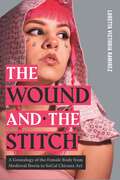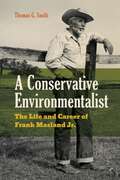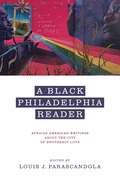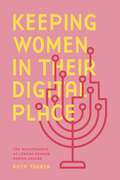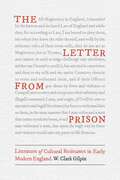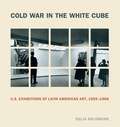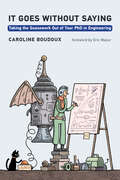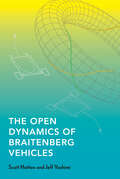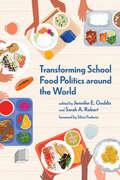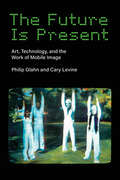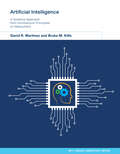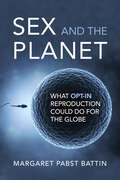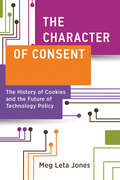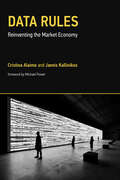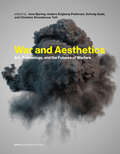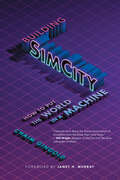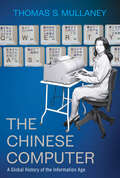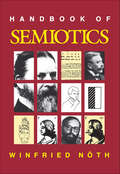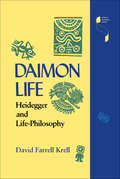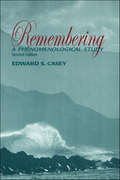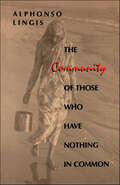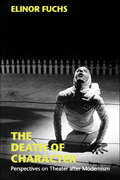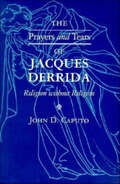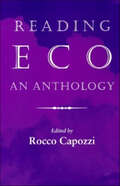- Table View
- List View
The Wound and the Stitch: A Genealogy of the Female Body from Medieval Iberia to SoCal Chicanx Art (RSA Series in Transdisciplinary Rhetoric)
by Loretta Victoria RamirezThe Wound and the Stitch traces a history of imagery and language centered on the concept of woundedness and the stitching together of fragmented selves. Focusing particularly on California and its historical violences against Chicanx bodies, Loretta Victoria Ramirez argues that woundedness has become a ubiquitous and significant form of Chicanx self-representation, especially in late twentieth-century print media and art.Ramirez maps a genealogy of the female body from late medieval Iberian devotional sculptures to contemporary strategies of self-representation. By doing so, she shows how wounds—metaphorical, physical, historical, and linguistic—are inherited and manifested as ongoing violations of the body and othered forms of identity. Beyond simply exposing these wounds, however, Ramirez also shows us how they can be healed—or rather stitched. Drawing on Mesoamerican concepts of securing stability during lived turmoil, or nepantla, Ramirez investigates how creators such as Cherríe Moraga, Renee Tajima-Peña, Guillermo Gómez-Peña, and Amalia Mesa-Bains repurpose the concept of woundedness to advocate for redress and offer delicate, ephemeral moments of healing.Positioning woundedness as a potent method to express Chicanx realities and transform the self from one that is wounded to one that is stitched, this book emphasizes the necessity of acknowledgment and ethical restitution for colonial legacies. It will be valued by scholars and students interested in the history of rhetorics, twentieth-century Chicanx art, and Latinx studies.
A Conservative Environmentalist: The Life and Career of Frank Masland Jr.
by Thomas G. SmithA wealthy textile titan from Carlisle, Pennsylvania, Frank Masland Jr. was an ardent political conservative and an equally fervent conservationist who was well known and highly respected in the mid-twentieth-century environmental preservation community. This eye-opening biography charts Masland’s life work, telling the story of how he and fellow Republicans worked with Democrats to expand the national park system, preserve wild country, and protect the environment. Though a conservative conservationist appears to be a contradiction in terms today, this was not necessarily the case when Masland and his compatriots held sway. Conservatives, Masland insisted, had a duty to be good stewards of the earth for present and future generations, and they worked closely with members of both parties in Congress and nonpolitical conservation groups to produce landmark achievements. When conservatives turned against environmentalism during the Reagan presidency, Masland refused to join what historians have termed the “Republican reversal.” During his long life of nearly a hundred years, Masland used his voice, influence, experiences with nature, and considerable wealth to champion environmental causes at the national, state, and local levels. Engaging, informative, and at times eyebrow-raising, this portrait of a passionately anti-statist nature-loving Republican environmentalist documents the history of the twentieth-century conservation movement and reminds us of a time when conservative Republicans could work with liberal Democrats to protect the environment.
A Black Philadelphia Reader: African American Writings About the City of Brotherly Love
by Louis J. ParascandolaThe relationship between the City of Brotherly Love and its Black residents has been complicated from the city’s founding through the present day. A Black Philadelphia Reader traces this complex history in the words of Black writers who were native to, lived in, or had significant connections to the city. Featuring the works of famous authors—including W. E. B. Du Bois, Harriet Jacobs, Sonia Sanchez and John Edgar Wideman—alongside lesser-known voices, this reader is an immersive and enriching composite portrait of the Black experience in Philadelphia. Through fiction and nonfiction, poetry and prose, readers witness episodes of racial prejudice and gender inequality in areas like public health, housing, education, policing, criminal justice, and public transportation. And yet amid these myriad challenges, the writers convey an enduring faith, a love of family and community, and a hope that Philadelphia will fulfill its promises to its Black citizens.Thoughtfully introduced and accompanied by notes that contextualize the works and aid readers’ comprehension, this book will appeal to a wide audience of Philadelphians and other readers interested in American, African American, and urban studies.
Keeping Women in Their Digital Place: The Maintenance of Jewish Gender Norms Online
by Ruth TsuriaSince its inception, the internet has been theorized as a democratic force, a public sphere in which hierarchies are flattened. But the internet is not a neutral tool; it has the power to amplify and mirror certain opinions and, as a result, can concretize social norms. So what happens when matters of religious practice and gender identity collide in these—often unregulated—online spaces?In Keeping Women in Their Digital Place, Ruth Tsuria explores how Orthodox Jewish communities in the United States and Israel have used “digital enclaves”—online safe havens created specifically for their denominations—to renegotiate traditional values in the face of taboo discourse encountered online. Combining a personal narrative with years of qualitative analysis, Tsuria examines how discussions in blogs and forums and on social media navigate issues of modesty, dating, marriage, intimacy, motherhood, and feminism. Unpacking the complexity of religious uses of the internet, Tsuria shows how the participatory qualities of digital spaces have been used both to challenge accepted norms and—more pervasively—to reinforce traditional and even extreme attitudes toward gender and sexuality.Original and engaging, this book will appeal to media, feminist, and religious studies scholars and students, particularly those interested in religion in the digital age and Orthodox Jewish communities.
The Letter from Prison: Literature of Cultural Resistance in Early Modern England
by W. Clark GilpinLetters from prison testifying to deeply felt ethical principles have a long history, extending from antiquity to the present day. In the early modern era, the rise of printing houses helped turn these letters into a powerful form of political and religious resistance. W. Clark Gilpin’s fascinating book examines how letter writers in England—ranging from archbishops to Quaker women—consolidated the prison letter as a literary form.Drawing from a large collection of printed prison letters written from the reign of Henry VIII to the closing decades of the seventeenth century, Gilpin explores the genre's many facets within evolving contexts of reformation and revolution. The writers of these letters portrayed the prisoner of conscience as a distinct persona and the prison as a place of redemptive suffering where bearing witness had the power to change society.The Letter from Prison features a diverse cast of characters and a literary genre that combines drama and inspiration. It is sure to appeal to those interested in early modern England, prison literature, and cultural forms of resistance.
Cold War in the White Cube: U.S. Exhibitions of Latin American Art, 1959–1968 (Refiguring Modernism)
by Delia SolomonsIn 1959, the very year the Cuban Revolution amplified Cold War tensions in the Americas, museumgoers in the United States witnessed a sudden surge in major exhibitions of Latin American art. Surveying the 1960s boom of such exhibits, this book documents how art produced in regions considered susceptible to communist influence was staged on U.S. soil for U.S. audiences.Held in high-profile venues such as the Guggenheim Museum, the Walker Art Center, MoMA, and the Art Institute of Chicago, the exhibitions of the 1960s Latin American art boom did not define a single stylistic trend or the art of a single nation but rather attempted to frame Latin America as a unified whole for U.S. audiences. Delia Solomons calls attention to disruptive artworks that rebelled against the curatorial frames purporting to hold them and reveals these exhibitions to be complex contact zones in which competing voices collided. Ultimately, through multiple means—including choosing to exclude artworks with readily decipherable political messages and evading references to contemporary inter-American frictions—the U.S. curators who organized these shows crafted projections of Pan-American partnership and harmony, with the United States as leader, interpreter, and good neighbor, during an era of brutal U.S. interference across the Americas.Theoretically sophisticated and highly original, this survey of Cold War–era Latin American art exhibits sheds light on the midcentury history of major U.S. art museums and makes an important contribution to the fields of museum studies, art history, and Latin American modernist art.
Feminist Interpretations of Plato
by Nancy TuanaThe essays in this anthology explore the full spectrum of Plato's philosophy and are representative of the variety of perspectives within feminist criticism. The essays in the first section focus primarily on Plato's social and political theory, and in particular the place of women within the state. The second section concentrates on examining the role of the feminine within Plato's metaphysics and epistemology. Tuana introduces both sections and a detailed bibliography is included.
It Goes without Saying: Taking the Guesswork Out of Your PhD in Engineering
by Caroline BoudouxThe definitive toolkit for doctoral students in engineering on thesis—and journal article—preparation, project (and stress) management, IP protection, collaborations, and other aspects of the PhD journey.It shouldn't take a PhD to get a PhD, but sometimes the process can seem that confusing—even though, to the mentors and advisors, so obvious that it goes without saying. For doctoral students in engineering confronting this dilemma, Caroline Boudoux, an accomplished researcher and entrepreneur, provides a demystifying guide to the challenges—daunting, seemingly routine, and at times unexpected—of pursuing a PhD in this demanding field. In It Goes without Saying, Boudoux marshals her considerable experience mentoring graduate students, teaching doctoral workshops, and—not so long ago—earning her own PhD at MIT to give PhD candidates the know-how, and the confidence, to succeed.Among the topics this book takes up are: What a PhD is: the journey, the milestones, and the endgame.Technical questions about what a doctoral project in engineering is and how to lead one.Practical matters including tips on writing, from proposal to dissertation; ethics; and intellectual property.Personal concerns, such as dealing with expectations, imposter syndrome, and stress.From the mundane to the metaphysical, this user-friendly guide gives the doctoral student in engineering the tools to make it from Day 1 to the successful completion of the PhD in a timely, fully informed, and forward-looking manner.
The Open Dynamics of Braitenberg Vehicles
by Jeff Yoshimi Scott HottonAn introduction to dynamical systems theory, a detailed mathematical analysis of pairs of Braitenberg vehicles, and a look at how these results apply to the study of physical and biological organisms.Powering the concept of a Braitenberg vehicle, developed in 1984 by the Italian-Austrian cyberneticist Valentino Braitenberg, is the idea that simple systems can produce complex behaviors. A pair of interacting Braitenberg vehicles is simple, but they can meander, wind around, and follow each another in a number of ways. In this book, Scott Hotton and Jeff Yoshimi show how dynamical systems theory—in particular the theory of open dynamic systems—can be used to analyze pairs of these vehicles in great detail. The result of the authors&’ long-standing collaboration at the intersection of mathematics, philosophy, cognitive science, and biology, The Open Dynamics of Braitenberg Vehicles offers a rigorous mathematical foundation for embodied cognition, especially when it comes to two-way interactions between an agent and its environment.Following an introduction to dynamical systems theory, and the most detailed mathematical analysis of Braitenberg vehicles to date, Hotton and Yoshimi discuss how their results can be applied to the study of physical and biological systems. They also describe their work's relevance to debates in the philosophy of embodied cognitive science. Combining the best features of embodied and representational approaches to cognitive science, complete with code and simulations, The Open Dynamics of Braitenberg Vehicles provides an extremely accessible and visually rich look into the workings and applications of open dynamical systems.
Transforming School Food Politics around the World (Food, Health, and the Environment)
by Jennifer E. Gaddis and Sarah A. RobertHow to successfully challenge and transform public school-food programs to emphasize care, justice, and sustainability, with insights from eight countries across the Global North and South.School food programs are about more than just feeding kids. They are a form of community care and a policy tool for advancing education, health, justice, food sovereignty, and sustainability. Transforming School Food Politics around the World illustrates how everyday people from a diverse range of global contexts have successfully challenged and changed programs that fall short of these ideals. Editors Jennifer Gaddis and Sarah A. Robert highlight the importance of global and local struggles to argue that the transformative potential of school food hinges on valuing the gendered labor that goes into caring for, feeding, and educating children.Through accessible and inspiring essays, Transforming School Food Politics around the World shows politics in action. Chapter contributors include youths, mothers, teachers, farmers, school nutrition workers, academics, lobbyists, policymakers, state employees, nonprofit staff, and social movement activists. Drawing from historical and contemporary research, personal experiences, and collaborations with community partners, they provide readers with innovative strategies that can be used in their own efforts to change school food policy and systems. Ultimately, this volume sets the stage to reimagine school food as part of the infrastructure of daily life, arguing that it can and should be at the vanguard of building a new economy rooted in care for people and the environment.Contributors:Alexis Agliano Sanborn, Lisa Altmann, José Arimatea Barros Bezerra, Islandia Bezerra, Jennifer Black, Brooks Bowden, Christine C. Caruso, Cristiane Coradin, Rebecca Davis, Sinikka Elliott, Rachel Engler-Stringer, Debbie Field, Lucy Flores, Andrée Gacoin, Jennifer Gaddis, Michelle Gautreaux, Anne Hales, Karin Hjälmeskog, Anore Horton, Kristiina Janhonen, Jennifer LeBarre, Raven Lewis, Faye Mack, Marjaana Manninen, Brent Mansfield, Anne Moertel, Katsura Omori, Prerna Rana, Margaret Read, Emmanuelle Ricaud Oneto, Sarah A. Robert, Betsy Rosenbluth, Amy Rosenthal, Ludmir dos Santos Gomes, Sônia Fátima Schwendler, Amy Shollenberger, Courtney Smith, Seulgi Son, Jarrett Stein
The Future Is Present: Art, Technology, and the Work of Mobile Image (Leonardo)
by Cary Levine Philip GlahnA critical history of the pioneering art and technology group Mobile Image and their prescient work in communications, networking, and information systems.In The Future Is Present, Philip Glahn and Cary Levine tell the fascinating history of the visionary art group Mobile Image—founded by Kit Galloway and Sherrie Rabinowitz in 1977—which appropriated emerging technologies, from satellites to electronic message platforms. Based in Los Angeles, this under-studied collective worked amid urban crisis, a techno-boom, consolidating media power, and ascendant neoliberal politics. Mobile Image challenged fundamental conventions of the public sphere, democracy, communication, and political participation, as well as notions of power, representation, and identity.Glahn and Levine argue not only for the historical importance of Mobile Image, but also for a critical artistic process that is at once analytic and transformative. They weave themes such as embodiment and its mediation, public/private dialectics, and techno-utopian vision throughout the book, binding these projects to discourses around race, gender, and class, as well as margin and center, the local and the global. In today&’s world of ubiquitous digital re/production, networking, and social media, The Future Is Present shows how the work of Mobile Image continues to have profound implications for art, technology, and the politics of public and private experience.
Artificial Intelligence: A Systems Approach from Architecture Principles to Deployment (MIT Lincoln Laboratory Series)
by David R. Martinez Bruke M. KifleThe first text to take a systems engineering approach to artificial intelligence (AI), from architecture principles to the development and deployment of AI capabilities.Most books on artificial intelligence (AI) focus on a single functional building block, such as machine learning or human-machine teaming. Artificial Intelligence takes a more holistic approach, addressing AI from the view of systems engineering. The book centers on the people-process-technology triad that is critical to successful development of AI products and services. Development starts with an AI design, based on the AI system architecture, and culminates with successful deployment of the AI capabilities. Directed toward AI developers and operational users, this accessibly written volume of the MIT Lincoln Laboratory Series can also serve as a text for undergraduate seniors and graduate-level students and as a reference book. Key features:In-depth look at modern computing technologies Systems engineering description and means to successfully undertake an AI product or service development through deploymentExisting methods for applying machine learning operations (MLOps)AI system architecture including a description of each of the AI pipeline building blocksChallenges and approaches to attend to responsible AI in practice Tools to develop a strategic roadmap and techniques to foster an innovative team environment Multiple use cases that stem from the authors&’ MIT classes, as well as from AI practitioners, AI project managers, early-career AI team leaders, technical executives, and entrepreneurs Exercises and Jupyter notebook examples
Sex and the Planet: What Opt-In Reproduction Could Do for the Globe (Basic Bioethics)
by Margaret Pabst BattinWhat if human reproduction was always elective? A prominent bioethicist speculates about the possibilities—and the likely consequences.What would the world be like if all pregnancy was intended, not unintended as it is nearly half the time now? Considerably better, Margaret Pabst Battin suggests in Sex and the Planet, a provocative thought experiment with far-reaching real-world implications. Many of the world&’s most vexing and seemingly intractable issues begin with sex—when sperm meets egg, as Battin puts it—abortion, adolescent pregnancy, high-risk pregnancy, sexual violence, population growth and decline. Rethinking reproductive rights and exposing our many mistaken assumptions about sex, Sex and the Planet offers an optimistic picture of how we might solve these problems—by drastically curtailing unintended pregnancies using currently available methods.How we see this picture—as recommendation, prediction, utopian fantasy, totalitarian plot, hypothetical conjecture, or realistic solution—depends to a great degree on which of thirteen problematic assumptions we maintain, assumptions Battin works to identify and challenge. Taking on sensitive topics like abortion and rape and religious issues around contraception, she shows how a fully informed, nonideological approach could defuse much of the friction such issues tend to generate. Also, in her attention to male contraception and the asymmetry of female and male reproductive control, she pulls in the 50 percent of the human race—those with Y chromosomes—largely left out of discussions of reproductive health. Sex and the Planet, finally, takes a global view, inviting us to consider a possible—even plausible—reproductive future.
The Character of Consent: The History of Cookies and the Future of Technology Policy (Information Policy)
by Meg Leta JonesThe rich, untold origin story of the ubiquitous web cookie—what&’s wrong with it, why it&’s being retired, and how we can do better.Consent pop-ups continually ask us to download cookies to our computers, but is this all-too-familiar form of privacy protection effective? No, Meg Leta Jones explains in The Character of Consent, rather than promote functionality, privacy, and decentralization, cookie technology has instead made the internet invasive, limited, and clunky. Good thing, then, that the cookie is set for retirement in 2024. In this eye-opening book, Jones tells the little-known story of this broken consent arrangement, tracing it back to the major transnational conflicts around digital consent over the last twenty-five years. What she finds is that the policy controversy is not, in fact, an information crisis—it&’s an identity crisis.Instead of asking how people consent, Jones asks who exactly is consenting and to what. Packed into those cookie pop-ups, she explains, are three distinct areas of law with three different characters who can consent. Within (mainly European) data protection law, the data subject consents. Within communication privacy law, the user consents. And within consumer protection law, the privacy consumer consents. These areas of law have very different histories, motivations, institutional structures, expertise, and strategies, so consent—and the characters who can consent—plays a unique role in those areas of law. The Character of Consent gives each computer character its due, taking us back to their origin stories within the legal history of computing. By doing so, Jones provides alternative ways of understanding the core issues within the consent dilemma. More importantly, she offers bold new approaches to creating and adopting better tech policies in the future.
Data Rules: Reinventing the Market Economy (Acting with Technology)
by Jannis Kallinikos Cristina AlaimoA new social science framework for studying the unprecedented social and economic restructuring driven by digital data.Digital data have become the critical frontier where emerging economic practices and organizational forms confront the traditional economic order and its institutions. In Data Rules, Cristina Alaimo and Jannis Kallinikos establish a social science framework for analyzing the unprecedented social and economic restructuring brought about by data. Working at the intersection of information systems and organizational studies, they draw extensively on intellectual currents in sociology, semiotics, cognitive science and technology, and social theory. Making the case for turning &“data-making&” into an area of inquiry of its own, the authors uncover how data are deeply implicated in rewiring the institutions of the market economy.The authors associate digital data with the decentering of organizations. As they point out, centered systems make sense only when firms (and formal organizations more broadly) can keep the external world at arm&’s length and maintain a relative operation independence from it. These patterns no longer hold. Data transform the production of goods and services to an endless series of exchanges and interactions that defeat the functional logics of markets and organizations. The diffusion of platforms and ecosystems is indicative of these broader transformations. Rather than viewing data as simply a force of surveillance and control, the authors place the transformative potential of data at the center of an emerging socioeconomic order that restructures society and its institutions.
War and Aesthetics: Art, Technology, and the Futures of Warfare (Prisms: Humanities and War #1)
by Jens Bjering, Anders Engberg-Pedersen, Solveig Gade, and Christine Strandmose ToftA provocative edited collection that takes an original approach toward the black box of military technology, surveillance, and AI—and reveals the aesthetic dimension of warfare.War and Aesthetics gathers leading artists, political scientists, and scholars to outline the aesthetic dimension of warfare and offer a novel perspective on its contemporary character and the construction of its potential futures. Edited by a team of four scholars, Jens Bjering, Anders Engberg-Pedersen, Solveig Gade, and Christine Strandmose Toft, this timely volume examines warfare through the lens of aesthetics, arguing that the aesthetic configurations of perception, technology, and time are central to the artistic engagement with warfare, just as they are key to military AI, weaponry, and satellite surveillance.People mostly think of war as the violent manifestation of a political rationality. But when war is viewed through the lens of aesthesis—meaning perception and sensibility—military technology becomes an applied science of sensory cognition. An outgrowth of three war seminars that took place in Copenhagen between 2018 and 2021, War and Aesthetics engages in three main areas of inquiry—the rethinking of aesthetics in the field of art and in the military sphere; the exploration of techno-aesthetics and the wider political and theoretical implications of war technology; and finally, the analysis of future temporalities that these technologies produce. The editors gather various traditions and perspectives ranging from literature to media studies to international relations, creating a unique historical and scientific approach that broadly traces the entanglement of war and aesthetics across the arts, social sciences, and humanities from ancient times to the present. As international conflict looms between superpowers, War and Aesthetics presents new and illuminating ways to think about future conflict in a world where violence is only ever a few steps away.ContributorsLouise Amoore, Ryan Bishop, Jens Bjering, James Der Derian, Anthony Downey, Anders Engberg-Pedersen, Solveig Gade, Mark B. Hansen, Caroline Holmqvist, Vivienne Jabri, Caren Kaplan, Phil Klay, Kate McLoughlin, Elaine Scarry, Christine Strandmose Toft, Joseph Vogl, Arkadi Zaides
Building SimCity: How to Put the World in a Machine (Game Histories)
by Chaim GingoldA deep dive into the trailblazing simulation game SimCity, situating it in the history of games, simulation, and computing.Building SimCity explores the history of computer simulation by chronicling one of the most influential simulation games ever made: SimCity. As author Chaim Gingold explains, Will Wright, the visionary designer behind the urban planning game, created SimCity in part to learn about cities, appropriating ideas from traditions in which computers are used as tools for modeling and thinking about the world as a complex system. As such, SimCity is a microcosm of the histories and cultures of computer simulation that engages with questions, themes, and representational techniques that reach back to the earliest computer simulations.Gingold uses SimCity to explore a web of interrelated topics in the history of technology, software, and simulation, taking us far and wide—from the dawn of programmable computers to miniature cities made of construction paper and role-play. An unprecedented history of Maxis, the company founded to bring SimCity to market, the book reveals Maxis&’s complex relations with venture capitalists, Nintendo, and the Santa Fe Institute, which shaped the evolution of Will Wright&’s career; Maxis&’s failure to back The Sims to completion; and the company&’s sale to Electronic Arts.A lavishly visual book, Building SimCity boasts a treasure trove of visual matter to help bring its wide-ranging subjects to life, including painstakingly crafted diagrams that explain SimCity&’s operation, the Kodachrome photographs taken by Charles Eames of schoolchildren making model cities, and Nintendo&’s manga-style &“Dr. Wright&” character design, just to name a few.
The Chinese Computer: A Global History of the Information Age
by Thomas S. MullaneyThe fascinating, untold story of how the Chinese language overcame unparalleled challenges and revolutionized the world of computing.A standard QWERTY keyboard has a few dozen keys. How can Chinese—a language with tens of thousands of characters and no alphabet—be input on such a device? In The Chinese Computer, Thomas S. Mullaney sets out to resolve this paradox, and in doing so, discovers that the key to this seemingly impossible riddle has given rise to a new epoch in the history of writing—a form of writing he calls &“hypography.&” Based on fifteen years of research, this pathbreaking history of the Chinese language charts the beginnings of electronic Chinese technology in the wake of World War II up through to its many iterations in the present day.Mullaney takes the reader back through the history and evolution of Chinese language computing technology, showing the development of electronic Chinese input methods—software programs that enable Chinese characters to be produced using alphanumeric symbols—and the profound impact they have had on the way Chinese is written. Along the way, Mullaney introduces a cast of brilliant and eccentric personalities drawn from the ranks of IBM, MIT, the CIA, the Pentagon, the Taiwanese military, and the highest rungs of mainland Chinese establishment, to name a few, and the unexpected roles they played in developing Chinese language computing. Finally, he shows how China and the non-Western world—because of the hypographic technologies they had to invent in order to join the personal computing revolution—&“saved&” the Western computer from its deep biases, enabling it to achieve a meaningful presence in markets outside of the Americas and Europe.An eminently engaging and artfully told history, The Chinese Computer is a must-read for anyone interested in how culture informs computing and how computing, in turn, shapes culture.
Handbook of Semiotics (Advances in Semiotic)
by Winfried Nöth"This is the most systematic discussion of semiotics yet published." —Choice"A bravura performance." —Thomas Sebeok"Nöth's handbook is an outstanding encyclopedia that provides first-rate information on many facets of sign-related studies, research results, and applications." —Social Sciences in General
Daimon Life: Heidegger and Life-Philosophy (Studies in Continental Thought)
by David Farrell Krell"Daimon Life is life-enchancing. To read it is to become richer in wor(l)d." –John LlewelynDisclosure of Martin Heidegger's complicity with the National Socialist regime in 1933-34 has provoked virulent debate about the relationship between his politics and his philosophy. Did Heidegger's philosophy exhibit a kind of organicism readily transformed into ideological "blood and soil"? Or, rather, did his support of the Nazis betray a fundamental lack of loyalty to living things? David Farrell Krell traces Heidegger's political authoritarianism to his failure to develop a constructive "life-philosophy"—his phobic reactions to other forms of being. Krell details Heidegger's opposition to Lebensphilosophie as expressed in Being and Time, in an important but little-known lecture course on theoretical biology given in 1929–30 called "The Basic Concepts of Metaphysics," and in a recently published key text, Contributions to Philosophy, written in 1936–38. Although Heidegger's attempt to think through the problems of life, sexual reproduction, behavior, environment, and the ecosystem ultimately failed, Krell contends that his methods of thinking nonetheless pose important tasks for our own thought. Drawing on and away from Heidegger, Krell expands on the topics of life, death, sexuality, and spirit as these are treated by Freud, Nietzsche, Derrida, and Irigaray. Daimon Life addresses issues central to contemporary philosophies of politics, gender, ecology, and theoretical biology.
Remembering: A Phenomenological Study (Studies in Continental Thought)
by Edward S. CaseyRememberingA Phenomenological StudySecond EditionEdward S. CaseyA pioneering investigation of the multiple ways of remembering and the difference that memory makes in our daily lives.A Choice Outstanding Academic Book"An excellent book that provides an in-depth phenomenological and philosophical study of memory." —Choice". . . a stunning revelation of the pervasiveness of memory in our lives." —Contemporary Psychology"[Remembering] presents a study of remembering that is fondly attentive to its rich diversity, its intricacy of structure and detail, and its wide-ranging efficacy in our everyday, life-world experience. . . . genuinely pioneering, it ranges far beyond what established traditions in philosophy and psychology have generally taken the functions and especially the limits of memory to be." —The Humanistic PsychologistEdward S. Casey provides a thorough description of the varieties of human memory, including recognizing and reminding, reminiscing and commemorating, body memory and place memory. The preface to the new edition extends the scope of the original text to include issues of collective memory, forgetting, and traumatic memory, and aligns this book with Casey's newest work on place and space. This ambitious study demonstrates that nothing in our lives is unaffected by remembering.Studies in Continental Thought—John Sallis, general editorContentsPreface to the Second EditionIntroduction Remembering Forgotten: The Amnesia of AnamnesisPart One: Keeping Memory in MindFirst ForaysEidetic FeaturesRemembering as Intentional: Act PhaseRemembering as Intentional: Object PhasePart Two: Mnemonic ModesPrologueRemindingReminiscingRecognizingCodaPart Three: Pursuing Memory beyond MindPrologueBody MemoryPlace MemoryCommemorationCodaPart Four: Remembering Re-memberedThe Thick Autonomy of MemoryFreedom in Remembering
The Community of Those Who Have Nothing in Common (Studies in Continental Thought)
by Alphonso Lingis" . . . thought-provoking and meditative, Lingis's work is above all touching, and offers a refreshingly idiosyncratic antidote to the idle talk that so often passes for philosophical writing." —Radical Philosophy" . . . striking for the clarity and singularity of its styles and voices as well as for the compelling measure of genuine philosophic originality which it contributes to questions of community and (its) communication." —Research in PhenomenologyArticulating the author's journeys and personal experiences in the idiom of contemporary continental thought, Alphonso Lingis launches a devastating critique, pointing up the myopia of Western rationalism. Here Lingis raises issues of undeniable urgency.
The Death of Character: Perspectives on Theater after Modernism (Drama and Performance Studies)
by Elinor Fuchs"Extremely well written, and exceedingly well informed, this is a work that opens a variety of important questions in sophisticated and theoretically nuanced ways. It is hard to imagine a better tour guide than Fuchs for a trip through the last thirty years of, as she puts it, what we used to call the 'avant-garde.'" —Essays in Theatre". . . an insightful set of theoretical 'takes' on how to think about theatre before and theatre after modernism." —Theatre Journal"In short, for those who never experienced a 'postmodern swoon,' Elinor Fuchs is an excellent informant." —Performing Arts Journal". . . a thoughtful, highly readable contribution to the evolving literature on theatre and postmodernism." —Modern Drama"A work of bold theoretical ambition and exceptional critical intelligence. . . . Fuchs combines mastery of contemporary cultural theory with a long and full participation in American theater culture: the result is a long-needed, long-awaited elaboration of a new theatrical paradigm." —Una Chaudhuri, New York University"What makes this book exceptional is Fuchs' acute rehearsal of the stranger unnerving events of the last generation that have—in the cross-reflections of theory—determined our thinking about theater. She seems to have seen and absorbed them all." —Herbert Blau, Center for Twentieth Century Studies, University of Wisconsin, Milwaukee"Surveying the extraordinary scene of the postmodern American theater, Fuchs boldly frames key issues of subjectivity and performance with the keenest of critical eyes for the compelling image and the telling gesture." —Joseph Roach, Tulane University" . . . Fuchs makes an exceptionally lucid and eloquent case for the value and contradictions in postmodern theater." —Alice Rayner, Stanford University"Arguably the most accessible yet learned road map to what remains for many impenetrable territoryan obligatory addition to all academic libraries serving upper-division undertgraduates and above." —Choice"A systematic, comprehensive and historically-minded assessment of what, precisely, 'post-modern theatre' is, anyway." —American TheatreIn this engrossing study, Elinor Fuchs explores the multiple worlds of theater after modernism. While The Death of Character engages contemporary cultural and aesthetic theory, Elinor Fuchs always speaks as an active theater critic. Nine of her Village Voice and American Theatre essays conclude the volume. They give an immediate, vivid account of contemporary theater and theatrical culture written from the front of rapid cultural change.
The Prayers and Tears of Jacques Derrida: Religion without Religion (Indiana Series in the Philosophy of Religion Ser.)
by John D. Caputo"Caputo's book is riveting. . . . A singular achievement of stylistic brio and impeccable scholarship, it breaks new ground in making a powerful case for treating Derrida as homo religiosis. . . . There can be no mistaking the importance of Caputo's work." —Edith Wyschogrod"No one interested in Derrida, in Caputo, or in the larger question of postmodernism and religion can afford to ignore this pathbreaking study. Taking full advantage of the most recent and least discussed writings of Derrida, it offers a careful and comprehensive account of the religious dimension of Derrida's thought." —Merold Westphal
Reading Eco: An Anthology (Advances in Semiotics)
by Rocco Capozzi"[READING ECO is a timely indication] of the fruitfulness of perceiving Eco as the same in his metamorphoses. [It also testifies] to a certain price that Eco and his readers must/may pay for the enormous pleasure and intellectual stimulus of being Eco and being with Eco." —The ComparatistUmberto Eco is, quite simply, a genius. He is a renowned medievalist, philosopher, novelist, a popular journalist, and linguist. He is as warm and witty as he is learned—and quite probably the best-known academic and novelist in the world today. The goal of this anthology is to examine his ideas of literary semiotics and interpretation as evidenced both in his scholarly work and in his fiction.
